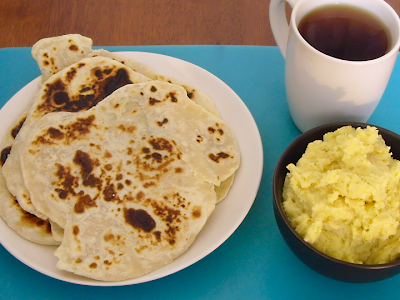Background
Tanzania was founded in 1964 when the states of Tanganyika and Zanzibar merged. Zanzibar consisted of two islands off the eastern coast and Tanganyika was on the mainland. Zanzibar has a history as a trading port which gave it contact with cultures from all over the Indian Ocean. Its major assets were spices and slaves. Zanzibar's cuisine is based around rice, and coconut and seems very similar to Indian food. The mainland diet is based around bean, cassava, and corn which is closer to its neighbors.
 I was surprised when I came across Tanzania Traditional Cookery in the library. It is basically a pamphlet bound in card-stock. The pages are inconsistently photocopied and the table of contents is only a rough guide on where to find the recipes. It also provided an entire section of breakfast food. Upon further examination all of the meals were listed under breakfast. This made me doubt the credibility of the categories given.
I was surprised when I came across Tanzania Traditional Cookery in the library. It is basically a pamphlet bound in card-stock. The pages are inconsistently photocopied and the table of contents is only a rough guide on where to find the recipes. It also provided an entire section of breakfast food. Upon further examination all of the meals were listed under breakfast. This made me doubt the credibility of the categories given.The second book we found was Tanzania Cookbook which had a far more credible table of contents. It fails to provide any information about when the dishes are usually served or the cultural heritage of the dishes. What makes this even stranger is that the blurb on the back of the book says that the book is for educational purposes. One of the major annoyances I have encountered in this project is books that purport to extol the virtues of a country's cuisine but give no cultural context about the dishes.
Given the absence of contextual and cultural information I went to the Internet. The Tanzanian Embassy webpage provided us with contextual information and a list of breakfast dishes. Once we had a list of dishes the cookbooks became useful.
We decided to go with ugali and chapatis served with chai tea. Ugali is a corn porridge that was compared to polenta in many recipes that I read. The chapatis use coconut milk which is different from past recipes.
Coconut Chapatis
- Mix flour and salt in a bowl.
- Add coconut milk and mix until it is doughy. Slowly add more coconut milk if required.
- Add ½ tablespoon of ghee to the dough and knead until it is smooth.
- Divide the dough into 6 evenly sized balls.
- Roll out a ball into a large flat circle.
- Cover circle with ½ tsp of ghee/oil.
- Make a slit along the radius of the dough and roll it into a cone.
- Seal the edges of the cone and squash it flat.
- Let them rest for 20 minutes.
- Heat a non-stick pan.
- Roll out the dough flat until it is about 1//8 of an inch thick.
- Melt some ghee in the pan put the flattened dough into the heated pan.
- As the uncooked side starts to puff spread some ghee and flip it.
Ugali
- 120 g fine corn meal
- ½ cup milk
- ½ cup water
- ½ tbsp butter (optional)
- salt (optional)
- Make a paste with the corn meal and milk.
- Bring the water to a boil, add the butter and salt.
- Stir in paste and then add the remaining maize flour.
- Continue to stir until it becomes stiff.
- Serve on top of warm chapatis.
Results and Discussion
The coconut milk in the chapatis gave the dough a much softer texture than previous recipes we had used. The layering technique used in making them gave them a flaky texture and the oil kept them very soft.
The ugali was very simple and a little bland. We also think it might have been under done. We halved the recipe from the one given in the cookbook and quantity of water and milk may have been too small to properly cook it. Another problem might have been our choice of corn meal. The recipe called for maize flour which according to my research is corn meal. Many recipes for ugali compare it to polenta for its texture. Fine corn flour may be too fine for our needs and using polenta might be a better substitute in the future.


No comments:
Post a Comment